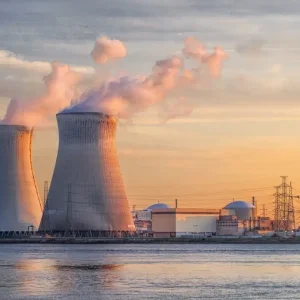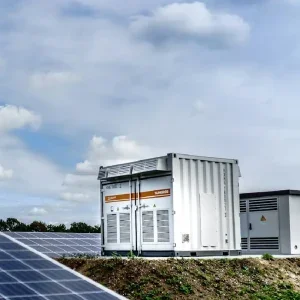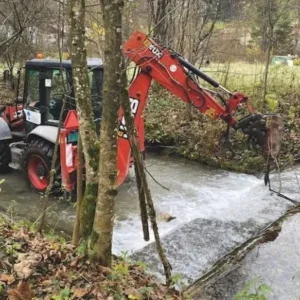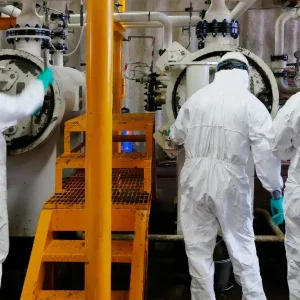By early June 2001, the New York Power Authority (NYPA) began operating three out of 11 gas turbine-generator sets in simple-cycle mode at various sites throughout the New York City area. NYPA plans to add more than 400 MWe of new generation for the peak summer period to avert a serious power crisis and ensure system reliability. The PowerNow! generating programme developed by NYPA is based on eleven GE LM6000 aeroderivative gas turbine packages to be situated at seven separate sites. The units were sold and supplied by GE Aero Energy Products, headquartered in Houston, Texas.
The LM6000-based plants, which are fired by natural gas, are a stop-gap measure until new, large NYPA power plants are operational over the next two or three years. The LM6000s will more than fulfill the 315 MWe shortfall NYPA has predicted for the summer of 2001.
Why new units?
The NYPA is the major provider of electricity in New York City. In March 2001, Eugene W Zeltmann, president and chief operating officer of the NYPA, gave testimony on its PowerNow! programme to various New York State assemblies and authorities. Zeltmann provided a thorough overview of the $510 million PowerNow! programme and the reasoning behind the NYPA’s endeavour.
“I sincerely hope that my testimony will help you better understand why we are so proud of our project to increase the supply of electricity in New York City and reduce the risk of blackouts and price spikes such as those which now plague the people of California,” said Zeltmann.
Zeltmann described how the PowerNow! concept came into being. The Chair of the Public Service Commission directed the Department of Public Service to work with all levels of the government, the NYPA, the New York Independent System Operator (NYISO), and private generation owners and electric utility companies to meet the challenges of this power shortage.
According to Zeltmann, “The New York State Energy Planning Board in its December 1, 2000 “Report on the reliability of New York’s Electric transmission and distribution system” recommended that the state meet the need for increased generation by the summer of 2001, including ‘supporting NYPA’s efforts to place 11 new gas turbines in the New York City and Long Island area.’”
The NYISO predicted New York City’s peak load for the summer of 2001 to be 10 545 MWe. Due to transmission constraints, the amount of electricity New York City can import from outside its borders is limited. That means that New York City needed to generate 80 per cent or 8 428 MWe of its own electric load within its borders to ensure reliability and meet power needs. However on 15 February 2001, NYISO stated that there was only 8 031 MWe of generation available in New York City, leaving a 397 MWe deficit.
As Zeltmann noted, other evidence mounted that supported NYPA’s PowerNow! programme. For instance, a report from the local utility Consolidated Edison estimated that 2000 to 3000 MW of additional generation is needed for New York City over the next five years. The report also concluded that:
• 700 to 900 MWe are needed to accommodate growth in demand;
• 800 to 1200 MWe are needed for market stability;
• 500 to 900 MWe will be required to replace ageing plants and equipment.
Zeltmann also cited the report Electricity outlook: a matter of urgency from the New York Building Congress, a group formed by the Association for a Better New York, the Building Construction Trades Council, the Real Estate Board and the New York City Partnership. It concluded that the NYPA gas turbines represent “the only immediate potential for additional supply in New York City.”
“The Power Authority’s efforts to address the challenge formally began on August 29, 2000 when the Trustees of the New York Power Authority approved the acquisition of the 11 small gas turbine generators,” said Zeltmann.
Site selection
The PowerNow! programme relied on initial site surveys taken in 1998 by Stone & Webster. NYPA also worked with the two local utilities, KeySpan and Consolidated Edison, and a New York real estate broker, to identify additional sites. NYPA outlined the following criteria for final site selection. The site must:
• Possess the ability for Consolidated Edison or KeySpan to deliver high-pressure natural gas to the site by 1 June 2001.
• Possess the ability to connect to a 138 kV substation with sufficient capacity to accept electricity from the new units by 1 June.
• Not have significant environmental impact on the surrounding communities.
• Be dispersed as much as possible throughout the five boroughs of New York City.
• Be able to complete essential real estate, engineering and licensing activities so that the generators could go into service by 1 June.
With criteria established, the NYPA set out to find suitable sites by following various steps, including community outreach activities, land acquisitions, gas and electric engineering, geo-technical investigation, site design and engineering, and environmental assessment.
The NYPA reviewed 60 potential sites, and on 22 November 2000, announced five of the seven final sites, all of which are zoned for industrial use:
• Hell Gate in the Bronx (two units);
• Harlem River Yards in the Bronx (two units);
• Vernon Boulevard in Queens (two units);
• River Street (North 1st and Grand) in Brooklyn (one unit);
• 23rd Street and Third Avenue in Brooklyn (one unit).
A sixth site was later identified at the Pouch Terminal on Staten Island, which will house the tenth LM6000. The seventh site, for the 11th LM6000, will be placed at the Pilgrim State Hospital in Brentwood, the Town of Islip, by request of the Long Island Power Authority.
The sites selected met the final PowerNow! criteria outlined by the NYPA. For instance, each site is between 1 to 11/2 acres and has natural gas supplies and electrical connections ready or nearby. In order to comply with air permits, power output will be limited to 79.9 MWe at sites that will use two LM6000s.
The gas turbine technology
“The PowerNow! gas turbines will be the quietest, cleanest power-producing facilities in New York City,” said Zeltmann. “The units are rated among the most fuel-efficient simple-cycle gas turbines in the world,” he added.
The LM6000 offers operational flexibility and the ability to be installed quickly and easily for fast-track projects.
GE AEP LM6000 packages feature a standardised, modular design. A large number of essentially identical packages are available because of GE AEP’s “inventory” approach to manufacturing. This factory-packaging concept provides flexibility to meet delivery requirements, making it possible to ship generator sets to new customers for fast-track projects.
The 60 Hz LM6000 gas turbines to be used by the NYPA are single-lift skid units (see table below for specifications).
The two-piece skid assembly is sectioned between the gas turbine and the generator compartments, and is designed for convenient transport.
The LM6000s feature redundant, oversized fans to provide filtered ventilation air for the turbine and generator compartment. This multi-stage filtering and conditioning system has provisions for a heater, chiller or evaporator cooler to avoid custom engineering. Finished filter modules are supported atop the main turbine-generator package with no additional foundations required.
The Brush air-cooled generators are designed to accommodate full gas turbine power output over the full ambient air temperature range, and are fully rated to accommodate future ratings increases. The gas turbines are controlled by Woodward Governor’s NetCon 5000 and GE Mark IV Millennium controls. Benefits of this control system include: remote-mounted I/O to reduce interconnect wiring; engine monitoring with integrated fuel control and sequencing; high-speed digital processing with integrated data logging/trending capability; and operator-friendly interface with on-line self-diagnostics.
Pollution concerns
The NYPA is spending an additional $5 million per LM6000 to ensure the PowerNow! plants are environmentally-friendly. Equipment will include a water injection system that, combined with selective catalytic reduction systems, will guarantee emissions levels of 2.5 ppm NOx and 5 ppm CO.
According to Zeltmann, “This voluntary offset program will ensure that the project will not cause any net increase, no matter how small, in air pollutants in New York City.”
The NYPA will also use information gathered from extensive evaluation studies to reduce noise levels so that there will be no significant impact on ambient levels at the plants.
Other initiatives
The NYPA is combining the PowerNow! programme with other conservation and clean energy initiatives. For instance during the summer of 2000, the NYPA instituted the Peak Load Management Incentive Program with larger government and business customers in New York City. Participating customers were paid for every kilowatt of demand that was cut on high-demand days. A total of 16 800 kWh was saved on each of the four days the plan was implemented. The Authority plans to institute the programme again during the summer of 2001.
The Authority is also pursuing several clean energy initiatives including:
• Fuel cells such as those installed to power a New York City Police
Department Precinct in Central Park.
• Solar power projects similar to the rooftop photovoltaics constructed on the Gun Hill Bus Depot in the Bronx.
• High-efficiency refrigerators like those installed at 180 000 public housing apartments throughout metropolitan New York.
On the demand side, the NYPA says its energy savings initiatives protect 144 000 New York City jobs and save New York City government customers and taxpayers about $250 million per year. Energy efficient lighting for government facilities improves illumination but also saves taxpayers nearly $34 million a year in electricity charges. The electricity saved, says NYPA, is enough to serve about 65 000 residents or provide about half of the electricity needs of Staten Island. These savings eliminated the need to build two additional small turbine units in New York City. NYPA also reports that it has replaced coal-fired furnaces at 78 New York schools, adopted energy-efficient traffic signals and introduced non-polluting electric vehicles to government agencies.
The hope is that all these efforts, in conjunction with the PowerNow! programme on the supply side, will alleviate potential power shortages in New York during the 2001 summer peak.
Tables
LM6000 60 Hz specifications






